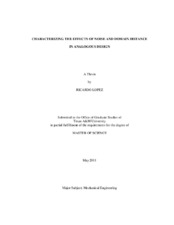Characterizing the Effects of Noise and Domain Distance in Analogous Design
Abstract
Idea generation is one of the major initial steps of the design process. Designers frequently use analogies to explain concepts, predict potential problems, and generate ideas. Analogous design can stimulate idea generation and lead to novelty and creativity. At present, there is little research that explores analogous design under the presence of irrelevant information, 'noise', or the effects of using analogies from semantically distant domains.
An "Analogies and Noise" experiment extends previous findings which indicate that the use of two analogues instead of one can enhance analogous transfer. It tests whether this holds true for increased numbers of analogies. This study hypothesizes that analogue transfer improves with increasing number of example analogues and deteriorates under the presence of noise. The experiment evaluated this hypothesis by presenting designers with a design problem and a set of analogues and noise. Improvement was primarily measured by the rate of participants identifying the relevant high level principle (HLP). The results indicate that: (1) recognition of HLPs deteriorates under noise (2) increasing numbers of analogues under noise initially improves HLP recognition; however, once many items are present, designers are overwhelmed and the HLP recognition rate decreases (3) using two analogues is optimal for design and (4) noise cannot be defined as all those items without a functional feature relevant to the problem.
A "Distant Domains" pilot experiment explores the use of distant-domain analogies. This study hypothesizes that distant domain analogies lead to more abstraction resulting in more creative designs. The experiment presented participants with a predetermined set of analogues then asked them to solve a problem. The set contained analogies from the problem domain and from a domain of varying distance. The following patterns were observed: (1) the number of emergent features peaked with near-domain analogies and decreased thereafter (2) the mean total number of ideas increased with increasing domain (3) designers deemed analogies from distant domains as 'less useful' and solutions generated using distant domains as 'less effective' and 'less practical'. These trends warrant future experimentation with an increased sample size.
Citation
Lopez, Ricardo (2011). Characterizing the Effects of Noise and Domain Distance in Analogous Design. Master's thesis, Texas A&M University. Available electronically from https : / /hdl .handle .net /1969 .1 /ETD -TAMU -2011 -05 -9510.


